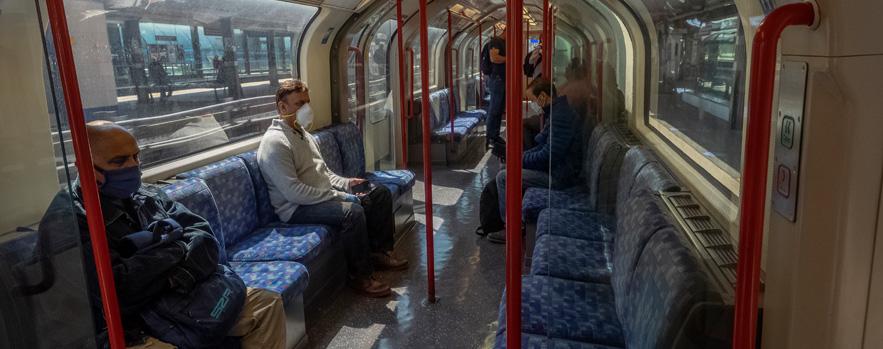
Submitted by Candy Smellie on Wed, 01/07/2020 - 15:27
Two journal publications co-authored by CSIC Research Associates Dr Manu Sasidharan and Dr Georgios M. Hadjidemetriou, and CSIC Investigator and Reader in Asset Management, Dr Ajith Parlikad, based at the Institute for Manufacturing, explore how human-mobility reduction strategies can help in fighting Covid-19 in the UK.
Human-mobility reduction measures provide the greatest benefit in the fight against Covid-19. We need to balance the public health benefits of closing public transport during a pandemic against the socio-economic impacts of reducing mobilityDr Manu Sasidharan
The first paper titled ‘A vulnerability-based approach to human-mobility reduction for countering COVID-19 transmission in London while considering local air quality’ published in Science of the Total Environment, and co-authored with colleagues Dr Ajit Singh, Postdoctoral Research Fellow, School of Geography, Earth and Environmental Sciences, and Dr Mehran Eskandari Torbaghan, Department of Civil Engineering, at the University of Birmingham, demonstrates a correlation between increased levels of nitrogen dioxide (N0₂) and particulate matter (PM₂.₅) pollution concentrations and higher risk of Covid-19 transmission and severe outcomes, including deaths.
Analysis demonstrated a strong correlation between increment in air pollution and an increase in the risk of Covid-19 transmission and fatality within London boroughs, demonstrating the possibility to employ air pollution as an indicator to rapidly identify the city's vulnerable regions. This approach can inform decisions to suspend or reduce the operation of different public transport modes within a city, and support planning for a range of human-mobility reduction strategies based on the vulnerability of a given region.
Dr Manu Sasidharan, said: “Human-mobility reduction measures provide the greatest benefit in the fight against Covid-19. We need to balance the public health benefits of closing public transport during a pandemic against the socio-economic impacts of reducing mobility. Determining the vulnerability of city regions to coronavirus might help to achieve such trade-offs – air pollution levels can serve as one of the indicators to assess this vulnerability.” This research has been reported on by iNews, Science Daily, and Air Quality News.
While individual risk of contracting and dying from Covid-19 is dependent on a number of different factors, the results of the report are informative for both scientists and decision-makers in their efforts to reduce the transmission and socio-economic impact of the ongoing outbreak through informed human-mobility reduction strategies. This study could be expanded to understand the effect (if any) of other air quality parameters such as volatile organic compounds (VOCs) and nitrogen oxides (NOx), on Covid-19 transmission and fatality rate. The number of positive Covid-19 cases considered in the study were only those reported at hospitals – it does not include people self-isolating due to Covid-19.
Impact of government measures and human mobility trend on Covid-19-related deaths
A second Covid-19-related paper titled ‘The impact of government measures and human mobility trend on Covid-19 related deaths in the UK’ has been published by Transport Research Interdisciplinary Perspectives. Written by CSIC Research Associates Dr Georgios M. Hadjidemetriou and Dr Manu Sasidharan, Dr Georgia Kouyialis, Data Scientist at Schlumberger Research, Cambridge, and Dr Ajith Parlikad CSIC Investigator and Reader in Asset Management, the paper uses driving, walking and transit real-time data to investigate the impact of government control measures on human mobility reduction, as well as the connection between trends in human-mobility and severe Covid-19 outcomes. Dr Georgios M. Hadjidemetriou said: “The results from our study indicates that some level of travel restrictions and social-distancing measures may need to continue to reduce the risk of a resurgence in the transmission of Covid-19 in the UK. Restricting the number of passengers in public transport and stations to comply with social-distancing measures may need to be implemented to encourage public transport usage safely.”
Human mobility was observed to gradually decrease as the government was announcing more measures, and it stabilised at a scale of around 80 per cent after a lockdown was imposed. The study shows that human-mobility reduction had a significant impact on reducing Covid-19-related deaths, thus providing crucial evidence in support of such government measures. While the number of Covid-19 related deaths is dependent on various factors, the results from this study show that initial control measures aimed at human-mobility reduction had a direct impact on the number of Covid-19 related deaths in the UK.
- 'A vulnerability-based approach to human-mobility reduction for countering COVID-19 transmission in London while considering local air quality’ by Manu Sasidharan, Ajit Singh, Mehran Eskandari Torbaghan and Ajith Kumar Parlikad is published in Science of The Total Environment.
- ‘The impact of government measures and human mobility trend on COVID-19 related deaths in the UK’ by Georgios M. Hadjidemetriou, Manu Sasidharan, Georgia Kouyialis, and Ajith Parlikad is published in Transport Research Interdisciplinary Perspectives.
